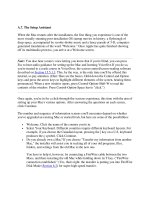Accessing the WAN – Chapter ppt
Bạn đang xem bản rút gọn của tài liệu. Xem và tải ngay bản đầy đủ của tài liệu tại đây (3.43 MB, 63 trang )
© 2006 Cisco Systems, Inc. All rights reserved. Cisco Public ITE I Chapter 6
1
Teleworker Services
Accessing the WAN – Chapter
Cisco Thai Nguyen Networking Academy
© 2006 Cisco Systems, Inc. All rights reserved. Cisco Public ITE 1 Chapter 6
2
Objectives
In this chapter, you will learn to:
– Describe the enterprise requirements for providing
teleworker services, including the differences between
private and public network infrastructures.
– Describe the teleworker requirements and recommended
architecture for providing teleworking services.
– Explain how broadband services extend enterprise networks
using DSL, cable, and wireless technology.
– Describe the importance of VPN technology, including its
role and benefits for enterprises and teleworkers.
– Describe how VPN technology can be used to provide
secure teleworker services to an enterprise network.
Cisco Thai Nguyen Networking Academy
© 2006 Cisco Systems, Inc. All rights reserved. Cisco Public ITE 1 Chapter 6
3
Business Requirement for Teleworker Services
With advances in broadband and wireless
technologies, working away from the office no longer
presents the challenges it did in the past.
– Organizations can cost-effectively distribute data,
voice, video, and real-time applications, across their
entire workforce no matter how remote and scattered
they might be.
On a broader scale, the ability of businesses to
provide service across time zones and international
boundaries is greatly enhanced using teleworkers.
– Contracting and outsourcing solutions are easier to
implement and manage.
From a social perspective, teleworking options
increase the employment opportunities for various
groups, including parents with small children, the
handicapped, and people living in remote areas.
– Teleworkers enjoy more quality family time, less travel-
related stress, and in general provide their employers
with increased productivity, satisfaction, and retention.
Cisco Thai Nguyen Networking Academy
© 2006 Cisco Systems, Inc. All rights reserved. Cisco Public ITE 1 Chapter 6
4
Teleworker Solution
With the growing number of teleworkers, enterprises
have an increasing need for secure, reliable, and
cost-effective ways to connect to people working in
small offices and home offices (SOHOs), and other
remote locations, with resources on corporate sites.
The figure displays 3 remote connection technologies
available to organizations for supporting teleworker:
1. Traditional private WAN Layer 2 technologies,
including Frame Relay, ATM, and leased lines, provide
many remote connection solutions.
2. IPsec Virtual Private Networks (VPNs) offer flexible
and scalable connectivity.
• Site-to-site connections can provide a secure, fast, and
reliable remote connection to teleworkers.
• This is the most common option for teleworkers,
combined with remote access over broadband, to
establish a secure VPN over the public Internet. (A less
reliable means of connectivity using the Internet is a
dialup connection.)
Cisco Thai Nguyen Networking Academy
© 2006 Cisco Systems, Inc. All rights reserved. Cisco Public ITE 1 Chapter 6
5
Teleworker Solution: Broadband Services
3. The term broadband refers to advanced
communications systems capable of providing high-
speed transmission of services, such as data, voice,
and video, over the Internet and other networks.
Transmission is provided by a wide range of
technologies, including
–digital subscriber line (DSL)
–fiber-optic cable,
–coaxial cable,
–wireless technology,
–satellite.
The broadband service data transmission speeds
typically exceed 200 kilobits per second (kb/s), or
200,000 bits per second, in at least one direction:
–downstream (from the Internet to the user's computer)
–upstream (from the user's computer to the Internet).
Cisco Thai Nguyen Networking Academy
© 2006 Cisco Systems, Inc. All rights reserved. Cisco Public ITE 1 Chapter 6
6
Remote Connection Topologies for the Teleworker
In general, broadband refers to
telecommunication in which a wide band of
frequencies is available to transmit information.
–Broadband is generally defined as any sustained
speed of 200K or more.
–Broadband options include
•digital subscriber line (DSL),
•high-speed cable modems,
•fast downstream data connections from direct
broadcast satellite (DBS)
•fixed wireless providers.
•3G wireless
–The most common problem with broadband
access is lack of coverage area.
• Broadband vs. Baseband.
– Baseband: only one
signal on the wire at
once - time-division
multiplexing:
• Ethernet networks.
– Broadband: multiple
signals - frequency
division multiplexing.
Cisco Thai Nguyen Networking Academy
© 2006 Cisco Systems, Inc. All rights reserved. Cisco Public ITE 1 Chapter 6
7
Teleworker Solution
To connect effectively to their organization's
networks, teleworkers need two key sets of
components:
–Home Office Components - The required home
office components are a laptop or desktop
computer, broadband access (cable or DSL), and
a VPN router or VPN client software installed on
the computer.
• When traveling, teleworkers need an Internet
connection and a VPN client to connect to the
corporate network over any available dialup, or
broadband connection.
–Corporate Components - Corporate
components are VPN-capable routers, VPN
concentrators, multifunction security appliances,
authentication, and central management devices
for resilient aggregation and termination of the
VPN connections.
Cisco Thai Nguyen Networking Academy
© 2006 Cisco Systems, Inc. All rights reserved. Cisco Public ITE 1 Chapter 6
8
Teleworker Solution
Typically, providing support for VoIP requires
upgrades to these components.
–Routers need Quality of Service (QoS)
functionality.
–QoS refers to the capability of a network to
provide better service to selected network traffic,
as required by voice and video applications.
The figure shows an encrypted VPN tunnel
connect the teleworker to the corporate network.
–This is the heart of secure and reliable teleworker
connections.
–A VPN is a private data network that uses the
public telecommunication infrastructure.
–VPN security maintains privacy using a tunneling
protocol and security procedures.
–This course presents the IPsec (IP Security)
protocol as the favored approach to building
secure VPN tunnels.
Cisco Thai Nguyen Networking Academy
© 2006 Cisco Systems, Inc. All rights reserved. Cisco Public ITE 1 Chapter 6
9
Options for Connecting the Teleworker
Split tunneling:
–Split tunneling is a computer networking
concept which allows a VPN user to access a
public network (e.g., the Internet) and a local
LAN or WAN at the same time,
•The remote user, for example, then downloads his
email from the mail server at 10.10.0.5, and
downloads a document from the Archive at
10.2.3.4. Next, without exiting the tunnel, the
remote user can print the document through the
PC's local network interface 192.19.2.32 to the
printer at 192.19.2.33.
–Advantages
•An advantage of using split tunneling is that it
alleviates bottlenecks and conserves bandwidth as
Internet traffic does not have to pass through the
VPN server.
–Disadvantages
•A disadvantage of this method is that it essentially
renders the VPN vulnerable to attack as it is
accessible through the public, non-secure network.
Cisco Thai Nguyen Networking Academy
© 2006 Cisco Systems, Inc. All rights reserved. Cisco Public ITE 1 Chapter 6
10
Connecting Teleworker to the WAN
Teleworkers typically use diverse applications
(e-mail, web, voice, and videoconferencing) that
require a high-bandwidth connection:
–Dialup access - Dialup is the slowest option,
and is typically used by mobile workers in areas
where high speed connection are not available.
–DSL - DSL also uses telephone lines. DSL uses
a special modem that separates the DSL signal
from the telephone signal and provides an
Ethernet connection to a host computer or LAN.
–Cable modem - The Internet signal is carried on
the same coaxial cable that delivers cable TV. A
special cable modem separates the Internet signal
from the other signals and provides an Ethernet
connection to a host computer or LAN.
–Satellite - The computer connects to a satellite
modem that transmits radio signals to the nearest
point of presence within the satellite network.
Cisco Thai Nguyen Networking Academy
© 2006 Cisco Systems, Inc. All rights reserved. Cisco Public ITE 1 Chapter 6
11
What is a Cable System?
John Walson the founder of the cable television.
–He was the first cable operator to use microwave to
import distant television stations,
–He was the first to use coaxial cable to improve picture
quality, and the distribute pay television programming.
Cable television first began in Pennsylvania in
1948. John Walson, the owner of an appliance store
in a small mountain town, needed to solve poor
over-the-air reception problems experienced by
customers trying to receive TV signals from
Philadelphia through the mountains.
–Walson erected an antenna on a utility pole on a local
mountaintop that enabled him to demonstrate the
televisions in his store with strong broadcasts coming
from the three Philadelphia stations.
–He connected the antenna to his appliance store via a
cable and modified signal boosters.
–He then connected several of his customers who were
located along the cable path.
–This was the first community antenna television
(CATV) system in the United States.
/>php?PHPSESSID=bad26d0ac5fd
8e02fb67d0d5045a6fab
Cisco Thai Nguyen Networking Academy
© 2006 Cisco Systems, Inc. All rights reserved. Cisco Public ITE 1 Chapter 6
12
What is a Cable System?
The “cable” in cable system refers to the coaxial
cable that carries radio frequency (RF) signals
across the network. Coaxial cable is the primary
medium used to build cable TV systems.
A typical cable operator now uses a satellite
dish to gather TV signals. Early systems were
one-way with cascading amplifiers placed in
series along the network to compensate for
signal loss.
–Taps were used to couple video signals from the
main trunks to subscriber homes via drop cables
Modern cable systems provide two-way
communication between subscribers and the
cable operator.
–Cable operators now offer customers advanced
telecommunications services including high-speed
Internet access, digital cable television, and
residential telephone service.
–(e.g. impulse-pay-per-view, home shopping,
Internet access),
Cisco Thai Nguyen Networking Academy
© 2006 Cisco Systems, Inc. All rights reserved. Cisco Public ITE 1 Chapter 6
13
What is a Cable System?
One Way Cable Modems
–In this system, communications in the down
direction is by cable but the return path is by
conventional telephone line and telephone
modem (33 Kbps).
•Some companies have a modem box which
connects to both your telephone line and to the cable
TV system. The box then connects to your computer
via either a USB port or an Ethernet port.
Two way Cable Modems
–Two way cable systems transmit data in both
directions via cable and therefore do not need a
telephone line. Uplink speeds are typically higher
than 56K modem but not as high as downlink
speeds.
–Cable modem service is always-on and so the
problems with busy signals, connect time, and
disconnects are eliminated.
–These systems generally permanently assign a
dedicated internet address (IP number) to each
user which allows the use of services where your
friends need to know your Internet address such
as ICQ or netphone.
1-way vs. 2 way
/>rticles/cablemodem.htm
Cisco Thai Nguyen Networking Academy
© 2006 Cisco Systems, Inc. All rights reserved. Cisco Public ITE 1 Chapter 6
14
Cable Technology Terms
The following terms describe key cable technologies:
–Broadband: In cable systems, broadband refers to the frequency-
division multiplexing (FDM) of many signals in a wide RF bandwidth
over a hybrid fiber-coaxial (HFC) network.
–Community antenna television (CATV): The term now widely
refers to residential cable systems.
–Coaxial cable: Coaxial cable transports RF signals and has certain
physical properties that define the attenuation of the signal. These
properties include cable diameter, dielectric construction, ambient
temperature, and operating frequency.
–Tap: A tap divides the input signal's RF power to support multiple
outputs. Typically, the cable operators deploy taps with two, four, or
eight ports called subscriber drop connections. (Passive)
–Amplifier: An amplifier magnifies an input signal and produces a
significantly larger output signal. (Active)
–Hybrid fiber-coaxial (HFC): HFC is a mixed optical-coaxial
network in which optical fiber replaces the lower bandwidth coaxial
where useful in the traditional trunk portion of the cable network.
–Downstream: This is the direction of an RF signal transmission (TV
channels and data) from the source (headend) to the destination
(subscribers). Transmission from source to destination is called the
forward path.
–Upstream: This is the direction of an RF signal transmission
opposite to downstream: from subscribers to the headend, or the
return or reverse path.
Figure: HFC Architecture
Tap
Amplifier
Cisco Thai Nguyen Networking Academy
© 2006 Cisco Systems, Inc. All rights reserved. Cisco Public ITE 1 Chapter 6
15
Cable Technology Terms
The following terms describe key cable technologies:
–Value 768 kbps
Upload Speed 256kbps
–Basic 2.0 Mbps
Upload Speed 384kbps
–Advanced 4.0 Mbps
Upload Speed 512kbps
–Ultra 6.0 Mbps
Upload Speed 512kbps.
–Ultra Plus 6.0 Mbps
Upload speed of 1Mbps.
Upstream vs. Downstream
Cisco Thai Nguyen Networking Academy
© 2006 Cisco Systems, Inc. All rights reserved. Cisco Public ITE 1 Chapter 6
16
Cable System Components
CATV distributes TV channels collected at a central
location, called a headend, to subscribers over a
branched network of optical fibers, coaxial cables,
and broadband amplifiers.
¾ There are five major components of a cable system:
¾Antenna site: The location of an antenna site is chosen
for optimum reception of over-the-air, satellite signals.
¾Headend: The headend is a master facility where
signals are first received, processed, formatted, and then
distributed downstream to the cable network.
¾Transportation network: A transportation network links
a remote antenna site to a headend. The transportation
network can be microwave, coaxial, or fiber-optic.
¾Distribution network: In a classic cable system called a
tree-and-branch cable system, the distribution network
consists of trunk and feeder cables. The trunk is the
backbone that distributes signals throughout the
community service area to the feeder. The feeder
branches flow from a trunk and reach all of the
subscribers in the service area.
¾Subscriber drop: A subscriber drop connects the
subscriber to the cable services. The subscriber drop is a
connection between the feeder part of a distribution
network and the subscriber terminal device (for example,
TV set or cable modem).
Cisco Thai Nguyen Networking Academy
© 2006 Cisco Systems, Inc. All rights reserved. Cisco Public ITE 1 Chapter 6
17
Cable System Benefits
The cable system architecture provides a
cost-effective solution for densely populated
areas by cascading a broadcast architecture
to the users.
The development of cable systems made new
services possible.
–Cable systems support telephony and data
services and analog and digital video services.
Businesses that employ teleworkers can gain
the following benefits from this widely
available high-speed cable Internet access
method:
–VPN connectivity to corporate intranets
–SOHO capabilities for work-at-home employees
–Interactive television
–Public switched telephone network (PSTN)-
quality voice and fax calls over the managed IP
networks
www.conniq.com/InternetAccess_cable.htm
Cisco Thai Nguyen Networking Academy
© 2006 Cisco Systems, Inc. All rights reserved. Cisco Public ITE 1 Chapter 6
18
Sending Digital Signals over Radio Waves
When users tune a radio set across the RF
spectrum to find different radio stations, they tune
the radio to different electromagnetic frequencies
across that RF spectrum.
–The same principle applies to the cable system.
The cable TV industry uses a portion of the RF
electromagnetic spectrum.
–At the subscriber end, equipment such as TVs,
VCRs, and High Definition TV set-top boxes tune to
certain frequencies that allow the user to view the
TV channel or to receive high-speed Internet access.
A cable network is capable of transmitting signals
on the cable in either direction at the same time.
The following frequency scope is used:
–Downstream: Transmitting the signals from the
cable operator to the subscriber, the outgoing
frequencies are in the range of 50 to 860 MHz.
–Upstream: Transmitting the signals in the reverse
path from the subscriber to the cable operator, the
incoming frequencies are in the range of 5 to 42
MHz.
43–50 MHz: Cordless telephones, "49 MHz"
FM walkie-talkies, and mixed 2-way mobile
communication
Downstream: Headend-to-
subscriber has 810 MHz of
RF bandwidth.
Upstream: Subscriber-to-
headend has 37 MHz of RF
bandwidth.
Cisco Thai Nguyen Networking Academy
© 2006 Cisco Systems, Inc. All rights reserved. Cisco Public ITE 1 Chapter 6
19
Sending Digital Signals over Radio Waves
When a cable company offers Internet access
over the cable, Internet use the same cables
–the cable modem system puts downstream data
data sent from the Internet to an individual
computer into a 6-MHz channel.
•On the cable, the data looks just like a TV channel.
So Internet downstream data takes up the same
amount of cable space as any single channel of
programming.
–Upstream data information sent from an
individual back to the Internet requires even
less of the cable's bandwidth, just 2 MHz, since
the assumption is that most people download far
more information than they upload.
Putting both upstream and downstream data on
the cable television system requires two types
of equipment: a cable modem on the customer
end and a cable modem termination system
(CMTS) at the cable provider's end.
Cisco Thai Nguyen Networking Academy
© 2006 Cisco Systems, Inc. All rights reserved. Cisco Public ITE 1 Chapter 6
20
The Data-over-Cable Service Interface Specification (DOCSIS)
DOCSIS is an international standard developed by
CableLabs, a nonprofit research and development
consortium for cable-related technologies.
–CableLabs tests and certifies cable equipment such as
cable modem and cable modem termination systems.
DOCSIS specifies the Open Systems Interconnection
(OSI) Layers 1 and 2 requirements:
–Physical layer: For data signals that the cable operator can
use, DOCSIS specifies the channel widths (bandwidths of
each channel)
•DOCSIS 1.0: 200 kHz, 400 kHz, 800 kHz, 1.6 MHz, 3.2 MHz,
•DOCSIS 2.0: 6.4 MHz.
–MAC layer: Defines a deterministic access method (time-
division multiple access [TDMA] or synchronous code
division multiple access [S-CDMA]).
DOCSIS currently uses two standards, and a third
standard is under development:
–DOCSIS 1.0 was the first standard issued in March 1997.
–DOCSIS 2.0 was released in January 2002.
•DOCSIS 2.0 enhanced upstream transmission speeds and QoS
capabilities.
–DOCSIS 3.0 is under development and expected to feature
channel bonding, enabling the use of multiple downstream
and upstream channels.
Cisco Thai Nguyen Networking Academy
© 2006 Cisco Systems, Inc. All rights reserved. Cisco Public ITE 1 Chapter 6
21
The Data-over-Cable Service Interface Specification
¾ Plans for frequency allocation bands differ between North American
and European cable systems.
¾Euro-DOCSIS is adapted for use in Europe.
¾The main differences between DOCSIS and Euro-DOCSIS relate to
channel bandwidths.
¾ TV technical standards vary across the world, which affects the way
DOCSIS variants develop.
¾International TV standards include NTSC in North American and parts of
Japan;
¾PAL in most of Europe, Asia, Africa, Australia, Brazil, and Argentina;
¾SECAM in France and some Eastern European countries.
Cisco Thai Nguyen Networking Academy
© 2006 Cisco Systems, Inc. All rights reserved. Cisco Public ITE 1 Chapter 6
22
Hybrid Fiber-Coaxial (HFC) Cable Networks
Accessing the Internet through a cable network is a
popular option that teleworkers can use to access
their enterprise network.
–A significant drawback of only using coaxial cable is
the signal attenuation that happens when the signal
travels from the antenna to the subscriber.
–Amplifiers placed approximately every 2000 feet, boost
signal strength and ensure that RF signals have
enough power to receive all channels for analog TV,
digital TV, and digital data cable modem services.
Modern cable operators use an HFC network that
deploys fiber in the trunks:
–Reduces the number of amplifiers
–Thin and lightweight—takes less space
–Covers longer distances
–Induces less or virtually no noise
–Less loss of signal
–Immune to external influences, such as thunder or RF
interference
–Easier to handle
Cisco Thai Nguyen Networking Academy
© 2006 Cisco Systems, Inc. All rights reserved. Cisco Public ITE 1 Chapter 6
23
Hybrid Fiber-Coaxial (HFC) Cable Networks
HFC architecture is relatively simple. A
web of fiber trunk cables connects the
headend (or hub) to the nodes where
optical-to-RF signal conversion takes
place.
–Fiber trunks carry downstream traffic at a
signal strength above 50 decibels (dB) and
reduce the number of cable amplifiers in
trunk lines.
–Coaxial cable is already in place throughout
many neighborhoods, so cable operators
can build an HFC network without having to
replace existing coaxial cable between
nodes and subscribers.
Cisco Thai Nguyen Networking Academy
© 2006 Cisco Systems, Inc. All rights reserved. Cisco Public ITE 1 Chapter 6
24
Sending Data over Cable
Two types of equipment are required to send
digital modem signals upstream and downstream
on a cable system:
–A cable modem (CM) on the subscriber end
–A cable modem termination system (CMTS) at the
headend of the cable operator
In a modern HFC network, 500 to 2000 active data
subscribers are typically connected to a cable
network segment, all sharing the upstream and
downstream bandwidth.
–The actual bandwidth for Internet service over a
CATV line can be up to 27 Mbps on the download
path to the subscriber and about 2.5 Mbps of
bandwidth on the upload path.
•Based on the cable network architecture, cable operator
provisioning practices, and traffic load, an individual
subscriber can typically get an access speed of between
256 kb/s and 6 Mb/s.
Cisco Thai Nguyen Networking Academy
© 2006 Cisco Systems, Inc. All rights reserved. Cisco Public ITE 1 Chapter 6
25
Sending Data over Cable (cont.)
When high usage causes congestion,
the cable operator can add additional
bandwidth for data services by
allocating an additional TV channel
for high-speed data.
–This addition may effectively double the
downstream bandwidth that is available to
subscribers.
–Another option is to reduce the number of
subscribers served by each network
segment. To reduce the number of
subscribers, the cable operator further
subdivides the network by laying the fiber-
optic connections closer and deeper into
the neighborhoods.









